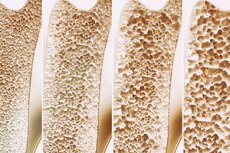New recommendations for the management of osteoporosis in men based on evidence-based medicine
Sist anmeldt: 14.06.2024

Alt iLive-innhold blir gjennomgått med medisin eller faktisk kontrollert for å sikre så mye faktuell nøyaktighet som mulig.
Vi har strenge retningslinjer for innkjøp og kun kobling til anerkjente medieområder, akademiske forskningsinstitusjoner og, når det er mulig, medisinsk peer-evaluerte studier. Merk at tallene i parenteser ([1], [2], etc.) er klikkbare koblinger til disse studiene.
Hvis du føler at noe av innholdet vårt er unøyaktig, utdatert eller ellers tvilsomt, velg det og trykk Ctrl + Enter.

It is estimated that one in five men over 50 years of age will experience an osteoporotic fracture in the rest of their lives, and the number of hip fractures in men is expected to increase by approximately 310% from 1990 to 2050. Despite the significant burden of osteoporosis among older men, the disease is still often viewed as a "women's" problem, and underdiagnosis and undertreatment of osteoporosis in men is even more common than in women.
In response, the international multidisciplinary working group of the European Society for the Clinical and Economic Aspects of Osteoporosis, Osteoarthritis and Musculoskeletal Diseases (ESCEO) issued recommendations based on the GRADE methodology for the diagnosis, monitoring and treatment of osteoporosis in men. p>
Professor Jean-Yves Regenster, senior author and President of ESCEO, said: "It is important to recognize that osteoporosis in men is associated with significant morbidity and mortality, comparable to or even greater than that of women with the disease."
"The ESCEO International Working Group was established to provide new recommendations for the management of osteoporosis, based on the latest advances in research and current expert opinions related to diagnostic and screening approaches to osteoporosis and its high risk of fractures in men."
The working group's recommendations cover disease burden, approaches to assessing fracture risk in men, including proper interpretation of densitometry and absolute fracture risk, thresholds for treatment and therapeutic interventions, along with their health economic evaluation.
The guidance also notes the need for more research into the effectiveness of anti-osteoporosis drugs, including denosumab and bone-forming therapies.
Key recommendations and guidelines that may be particularly useful for clinicians:
- For densitometric diagnosis of osteoporosis in men, a female reference database should be used.
- FRAX is a suitable tool for assessing fracture risk and establishing intervention thresholds in men with osteoporosis.
- Thresholds for FRAX-based intervention should depend on age in men with osteoporosis.
- Trabecular Bone Index, used in conjunction with BMD and FRAX probability, provides useful information for assessing fracture risk in men.
- All men with a previous fragility fracture should be considered for treatment with anti-osteoporosis drugs.
- The treatment regimen for osteoporosis in men should be tailored to their baseline fracture risk.
- Vitamin D and calcium should be provided to all men over 65.
- Oral bisphosphonates (alendronate or risedronate) are first-line treatments for men at high risk of fractures.
- Denosumab or zoledronate are second-line treatments for men at high risk of fractures.
- Sequence therapy, starting with a bone-forming agent and then an anti-resorption agent, should be considered for men at very high risk of fractures.
- Biochemical markers of bone turnover are a suitable tool for assessing adherence to anti-resorption therapy in men.
- Bone-forming agents prescribed as first-line treatment in men at very high risk of fracture should be used in accordance with regulatory recommendations.
- Exercise and a balanced diet should be recommended for all men with osteoporosis.
- Serum total testosterone levels should be assessed as part of the pretreatment workup in men with osteoporosis.
- Hormone replacement therapy should be considered in men with low levels of total or free testosterone.
- Based on available BMD data, abaloparatide is considered an appropriate first-line treatment for men with osteoporosis at very high risk of osteoporotic fracture.
Professor Nicholas Harvey, senior author and Chair of the International Osteoporosis Foundation's (IOF) Committee of Scientific Advisers, said: "We hope these guidelines will assist clinicians in their practice and encourage them to proactively manage osteoporosis in their male patients." p>
"Following an approach similar to that recommended for women with osteoporosis, we recommend the use of oral anti-resorption agents as first-line treatment in men at high risk of fractures, and bone-forming agents followed by anti-resorption agents in men at very high risk of fractures." risk of fractures."
IOF Chief Executive Officer Dr Philippe Hallbout concluded: “Osteoporosis in men represents a huge global burden and must be urgently addressed by health professionals and public health authorities. As the largest global organization for osteoporosis, the IOF welcomes the publication of this important new guidance, which will hopefully contribute to better patient care and reduce the devastating effects of osteoporosis in older men around the world."
The work was published in the journal Nature Reviews Rheumatology.
